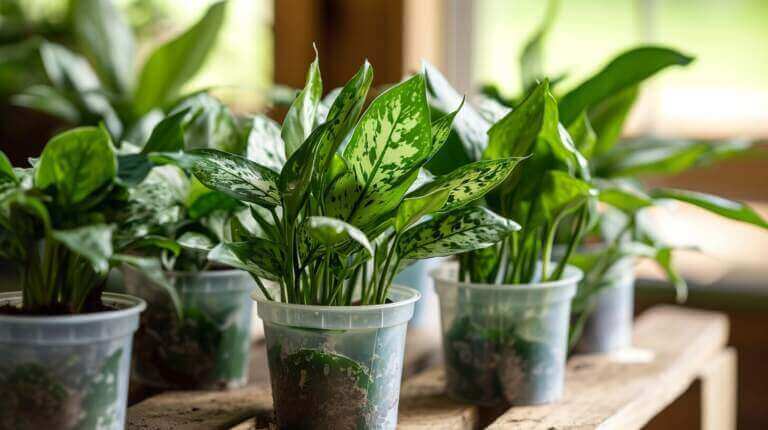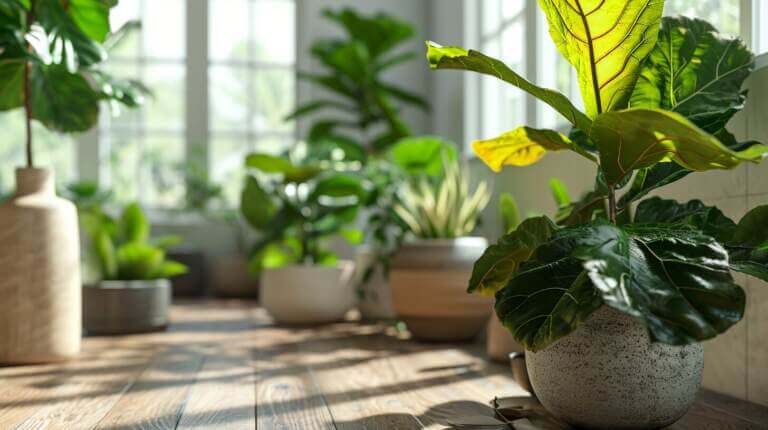Crotons are perennial evergreen shrubs known for their bold and tropical foliage. They can be grown both outdoors in warmer climates and as decorative houseplants. The leaves of crotons come in a wide variety of shapes and colors, including reds, oranges, yellows, pinks, purples, greens, and whites. They can grow up to 10 feet tall and are easy to propagate. Crotons thrive in full sun or partial shade and are best grown in subtropical regions. They add texture and color to indoor spaces and can be used to enhance floral arrangements.
Key Takeaways:
- Crotons are evergreen shrubs known for their bold and tropical foliage.
- The leaves of crotons display a wide range of shapes and vibrant colors.
- Crotons can be grown both indoors as houseplants and outdoors in subtropical regions.
- They thrive in full sun or partial shade and add texture and color to indoor spaces.
- Propagating and maintaining crotons is relatively easy, and they can be used to enhance landscaping and floral arrangements.
Characteristics of Croton Foliage
Crotons are known for their stunning foliage, which showcases a wide variety of shapes and colors. The leaves of croton plants can be long, narrow, oval, or even lobed, creating a unique and eye-catching display. In terms of color, croton foliage comes in shades of red, orange, yellow, pink, purple, green, and white, making them a vibrant addition to any garden or indoor space. Native to India and Malaysia, crotons typically grow in clusters, maximizing the beauty of their color patterns.
The diversity of leaf shapes and colors in croton foliage is truly remarkable. Not only do these plants offer striking patterns, but they also provide a tropical feel wherever they are planted. Whether used as houseplants or in outdoor landscapes, crotons add a splash of color and visual interest to any area. Their bold and vibrant foliage creates a focal point and complements other greenery or flowers.
When designing a garden or selecting indoor plants, consider incorporating crotons for their unique leaf characteristics. Their vibrant colors and varied leaf shapes make them stand out among other foliage plants. Whether you prefer a more traditional leaf shape or want to experiment with lobed or irregularly shaped leaves, crotons offer a wide range of options to suit your personal taste and style.
| Leaf Shape | Leaf Color |
|---|---|
| Long and narrow | Red, orange, yellow |
| Oval | Pink, purple |
| Lobed | Green, white |
As seen in the table above, croton foliage offers a wide range of leaf shapes and colors. This diversity allows for endless possibilities when it comes to designing your garden or indoor space. Whether you want to create a vibrant and tropical theme or add subtle accents of color, crotons can be the perfect choice to achieve your desired look.
Planting and Care Tips for Croton Foliage
When it comes to planting and caring for croton foliage, there are a few key factors to keep in mind. The proper planting technique and ongoing care will help ensure that your crotons thrive and display their vibrant leaf colors to their fullest potential.
Planting Croton
To begin, it is important to choose the right location for planting your crotons. These plants thrive in warm and humid conditions, so selecting a spot with full sun or partial shade is ideal. Ensure that the soil is well-drained and if planting in containers, make sure they have adequate water drainage to prevent waterlogged roots.
When planting crotons in a landscape, space them 2 to 3 feet apart to allow for proper air circulation and growth. This will also prevent overcrowding and ensure that each plant receives enough sunlight and nutrients.
Croton Care
Proper care is essential to maintain the health and vibrant foliage of your croton plants. Water your crotons frequently, but avoid overwatering as this can lead to root rot. Allow the top half-inch of soil to dry out before watering again. This will prevent the roots from becoming waterlogged and promote healthy growth.
Regarding sunlight, the amount of sun exposure needed depends on the specific cultivar of croton you have. Full sun or partial shade is generally recommended, but be sure to research the specific needs of your croton variety to ensure optimal growth.
In addition to watering and sunlight, regular monitoring is necessary to keep your croton plants pest-free. Common pests that can affect crotons include mealybugs, scales, mites, thrips, and fungal problems. By regularly inspecting your plants and taking appropriate action at the first sign of infestation, you can prevent damage and keep your crotons healthy.
| Planting Tips | Care Tips |
|---|---|
| Choose a location with full sun or partial shade | Water crotons frequently, allowing soil to dry out between watering |
| Ensure the soil is well-drained | Monitor for pests such as mealybugs, scales, mites, thrips, and fungal problems |
| Space crotons 2 to 3 feet apart in landscapes | Provide adequate sunlight based on the specific cultivar |
Croton Foliage as Houseplants
Crotons are not only stunning additions to outdoor landscapes but also make excellent houseplants. Their vibrant colors and unique leaf patterns can add a touch of tropical beauty to any indoor space. Cultivars like the petra croton are particularly well-suited for indoor conditions, as they retain their bright colors.
When growing crotons indoors, it’s important to provide them with bright indirect light. Place them near a window with filtered sunlight to maintain their vibrant foliage. However, be cautious not to expose them to direct sunlight, as it can scorch the leaves. If adequate light is not available, the colors may fade, and the plants may become leggy.
Like many houseplants, crotons thrive in a warm and humid environment. Aim to keep the temperature between 60-85°F and maintain moderate humidity levels. You can increase humidity by placing a tray filled with water near the plant or using a humidifier.
It’s essential to keep in mind that croton leaves are toxic to both humans and pets if ingested. Therefore, ensure they are placed out of reach and avoid placing them in areas where curious children or pets can access them. Regularly cleaning the leaves with a damp cloth will help remove dust and keep them looking their best.
| Light | Water | Temperature | Humidity |
|---|---|---|---|
| Bright indirect light | Keep the soil moist, but not waterlogged | 60-85°F | Moderate humidity |
Landscaping with Croton Foliage
Landscaping with croton foliage is a great way to add vibrant colors and eye-catching accents to your outdoor garden. Crotons, known for their bold and tropical foliage, can create a stunning display when planted in groups and combined with other shrubs and ornamentals.
When selecting crotons for your outdoor landscaping, choose cultivars that complement or contrast with the existing color patterns in your garden. The variety of leaf shapes and colors available in crotons allows for endless possibilities in creating unique and visually appealing designs.
One effective way to utilize croton foliage is to use them as color accents. Plant them strategically throughout your garden to create focal points or to break up monotonous green shrubbery. The vibrant hues of the croton leaves will add depth and visual interest to any yard or container garden.
Table 5.1: Croton Cultivars for Outdoor Landscaping
| Cultivar | Leaf Shape | Leaf Color | Height |
|---|---|---|---|
| Petra | Narrow | Red, Orange, Yellow | Up to 3 feet |
| Zanzibar | Lobed | Purple, Green, Yellow, Red | Up to 10 feet |
| Gold Dust | Narrow, Oval | Yellow, Green | Up to 6 feet |
Table 5.1 showcases a selection of popular croton cultivars that are commonly used in outdoor landscaping. These cultivars offer a range of leaf shapes, colors, and heights, allowing you to choose the perfect crotons to suit your garden design.
Tips for Propagating and Maintaining Croton Foliage
If you’re looking to expand your croton collection or share these beautiful plants with friends, propagation is a simple and effective method. To propagate crotons, start by selecting a healthy stem that is about 3-4 inches long and has 3 to 5 leaves. Dip the cutting in rooting hormone to encourage root development, then plant it in a small pot filled with moist soil. Keep the cutting in a warm environment with temperatures between 70-80°F, and within a month, you should see roots starting to form. Once the roots are established, you can transplant the new croton plant.
Maintaining croton foliage requires some regular care to keep the plants healthy and vibrant. It’s important to monitor for common pests such as spider mites, mealybugs, thrips, and scales. If you notice any signs of infestation, treat the affected plants promptly with an appropriate insecticide. In addition, keep the crotons clean by gently wiping the leaves with a damp cloth to remove dust and debris. This helps maintain the plant’s ability to absorb sunlight and keeps the foliage looking its best.
Proper watering and sunlight are also crucial for croton maintenance. Water the plants regularly, allowing the top half-inch of soil to dry out before watering again. Avoid overwatering, as excessive moisture can lead to root rot. Crotons prefer bright indirect sunlight, so place them in a location where they can receive plenty of light without direct exposure to harsh afternoon sun. With the right care and attention, your crotons will continue to thrive and showcase their stunning foliage.
FAQ
Can crotons be grown as houseplants?
Yes, crotons can be grown as decorative houseplants. They add texture and vibrant colors to indoor spaces.
What colors do croton leaves come in?
Croton leaves come in a wide variety of colors, including reds, oranges, yellows, pinks, purples, greens, and whites.
How tall can crotons grow?
Crotons can grow up to 10 feet tall.
What type of soil do crotons prefer?
Crotons prefer well-drained soil.
Can crotons be propagated?
Yes, crotons can be easily propagated through stem cuttings using rooting hormone.
Do crotons require a lot of sunlight?
Crotons thrive in full sun or partial shade, depending on the cultivar.
How often should crotons be watered?
Crotons should be watered frequently but not excessively. The top half-inch of soil should dry out before watering again.
Can croton leaves be toxic?
Yes, croton leaves can be irritating and poisonous, so it’s important to keep children and pets from nibbling on them.
Do crotons require regular maintenance?
Yes, crotons should be regularly monitored for pests and kept clean to ensure their health and vibrant foliage.
Can crotons be used in landscaping?
Yes, crotons can be used to add color and visual interest to outdoor landscapes. They are best suited for subtropical regions.







